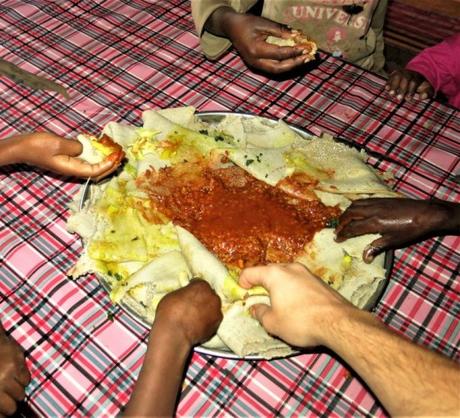

El "pan" etíope a base de teff, un cereal que solo crece en los altiplanos de Etiopía, sin gluten, con más proteínas y nutrientes que el trigo
Aprende a cocinar la injera etíope
Ingredientes: teff y agua
- 250 gramos de harina de trigo o de teff
- 400 mililitros de agua
Pasos y Elaboración:
- Mezcla en un bol o recipiente la harina con el agua y deja reposar la masa cubierta por un trapo limpio y seco.
- Deja la mezcla fermentar entre 1 y 3 días, hasta que veas burbujas en la masa.
- Agrega más agua hasta conseguir una textura líquida con consistencia para hacer tortitas y ponle un poco de sal si lo deseas. Calienta una sartén poniendo un poco de aceite en el fondo para que no se pegue y una vez esté caliente echa masa suficiente para hacer una tortita gruesa.
Nota: La injera solo se cocina por un lado así que ponle una tapa y ve vigilando hasta que veas que se forman pequeños agujeros en el pan y está cocinada la masa.
Aprende a cocinar injera
#Recetas
#cocinaEtíope
#injera
Injera, ənǧära እንጀራ [ɨndʒəra]; es un pan plano levantado de masa madre con una textura ligeramente esponjosa, originario de Eritrea y Etiopía.
Tradicionalmente hecho de harina de teff, es el plato nacional de Etiopía y Eritrea. Es fundamental para el proceso de comidas en esas culturas, ya que el pan es el componente más fundamental de cualquier comida etíope o eritrea.
La injera generalmente está hecha de pequeñas semillas de teff ricas en hierro, que se muelen en harina. Es relativamente costoso para el hogar promedio. Como muchos agricultores en las tierras altas de Etiopía cultivan sus propios granos de subsistencia, a veces se usa harina de trigo, cebada, maíz o arroz para reemplazar parte o la totalidad del contenido de teff. Las semillas de teff se clasifican según el color, se usan para hacer diferentes tipos de injera: nech (blanco), key o quey (rojo) y sergegna (mixto).
La harina de teff no contiene gluten.
Para hacer injera, la harina de teff se mezcla con agua. El proceso de fermentación se desencadena al agregar ersho, un líquido amarillo claro que se acumula en la superficie de la masa de harina de teff fermentada y se recolecta de fermentaciones previas. Ersho contiene especies de Bacillus (aeróbicas) y varias levaduras (en orden de abundancia): Candida milleri, Rhodotorula mucilaginosa, Kluyveromyces marxianus, Pichia naganishii y Debaromyces hansenii. Luego se deja fermentar la mezcla durante un promedio de dos a tres días, dándole un sabor ligeramente ácido. La injera se hornea en panqueques grandes y planos. La viscosidad de la masa permite que se vierta sobre la superficie de cocción, en lugar de extenderse, lo cual es inusual para una levadura o pan de masa fermentada.
En términos de forma, la injera se compara con la crepe francesa y la dosa india como un pan plano cocinado en círculo y utilizado como base para otros alimentos. En sabor y textura, es más similar a la indumentaria del sur de la India. La superficie inferior de la injera, que toca la superficie de calentamiento, tiene una textura relativamente suave, mientras que la parte superior es porosa. Esta textura porosa hace que la injera sea buena para recoger salsas y platos.
Tradicionalmente, la injera se elabora con solo dos ingredientes: Eragrostis tef, también conocido como teff, un grano antiguo de las tierras altas de Etiopía, y agua. Hay poco escrito o conocido sobre el origen de teff y, aunque no hay consenso académico, algunos creen que la producción de teff se remonta hasta el año 4000 a. C. Cuando el teff no está disponible, generalmente debido a su ubicación o limitaciones financieras, la injera se elabora mediante la fermentación de una variedad de granos diferentes, como cebada, mijo y sorgo. Sin embargo, el teff es el grano preferido para hacer injera, principalmente debido a sus atributos sensoriales (color, olor, sabor).
Injera, ənǧära እንጀራ [ɨndʒəra]; is a sourdough-risen flatbread with a slightly spongy texture, originating from the Eritrea and Ethiopia. Traditionally made out of teff flour, it is the national dish of Ethiopia and Eritrea. It is central to the dining process in those cultures as bread is the most fundamental component of any Ethiopian or Eritrean meal.[
Preparation
Injera is usually made from tiny, iron-rich teff seeds, which are ground into flour. Teff production is limited to certain middle elevations with adequate rainfall, and, as it is a low-yield crop, it is relatively expensive for the average household. As many farmers in the Ethiopian highlands grow their own subsistence grains, wheat, barley, corn, or rice flour are sometimes used to replace some or all of the teff content. Teff seeds are graded according to color, used to make different kinds of injera: nech (white), key or quey (red), and sergegna (mixed). Teff flour is gluten-free.
Batter is poured rapidly in a spiral from the outside inwards. Debre Markos, Ethiopia.
To make injera, teff flour is mixed with water. The fermentation process is triggered by adding ersho, a clear, yellow liquid that accumulates on the surface of fermenting teff flour batter and is collected from previous fermentations. Ersho contains (aerobic) Bacillus species and several yeasts (in order of abundance): Candida milleri, Rhodotorula mucilaginosa, Kluyveromyces marxianus, Pichia naganishii and Debaromyces hansenii.[8] [7] The mixture is then allowed to ferment for an average of two to three days, giving it a mildly sour taste. The injera is baked into large, flat pancakes. The dough's viscosity allows it to be poured onto the baking surface, rather than rolled out, which is unusual for a yeast or sourdough bread.
In terms of shape, injera compares to the French crêpe and the Indian dosa as a flatbread cooked in a circle and used as a base for other foods. In taste and texture, it is more similar to the South Indian appam. The bottom surface of the injera, which touches the heating surface, has a relatively smooth texture, while the top is porous. This porous texture makes injera good for scooping up sauces and dishes.
Ingredients
Traditionally, injera is made with just two ingredients - Eragrostis tef, also known as teff, an ancient grain from the highlands of Ethiopia, and water. There is little written or known about teff's origin[10] and while there is no scholarly consensus, some believe that the production of teff dates back as far as 4000 BC. When teff is not available, usually because of location or financial limitations, injera is made by fermenting a variety of different grains, including barley, millet, and sorghum. Teff is, however, the preferred grain for making injera, primarily because of its sensory attributes (color, smell, taste).
A variant of injera known as canjeelo is prepared from a dough of plain flour, self-raising flour, warm water, yeast, and salt. The mixture is beaten by hand until soft and creamy.Sorghum is the preferred flour for making canjeelo. There is a sweet-tasting version, and malawah, a variety made with eggs
Cooking method
The cooking method for injera has changed little since its origin. Traditionally, the flour is mixed with water and fermented for a short period of time. It is baked by pouring the mixture onto a giant circular griddle, known as a mitad.
Injera being cooked on a griddle.
Baking surface
Baking is done on a circular griddle - either a large black clay plate over a fire or a specialized electric stove. The griddle is known as a mitad (ምጣድ) (in Amharic) or mogogo (ሞጎጎ) (in Tigrinya). Mitads have been found at archaeological sites dating back as far as 600 AD. Nowadays, mitads are no longer always made out of clay, but can also be electric.

